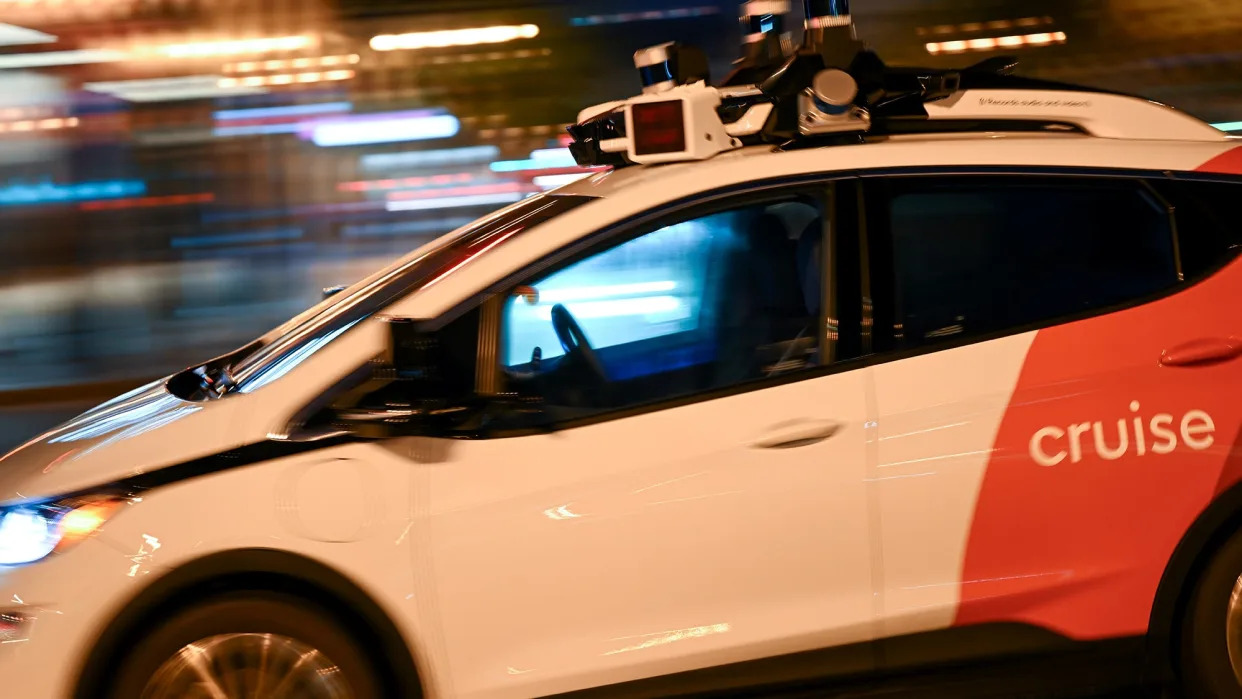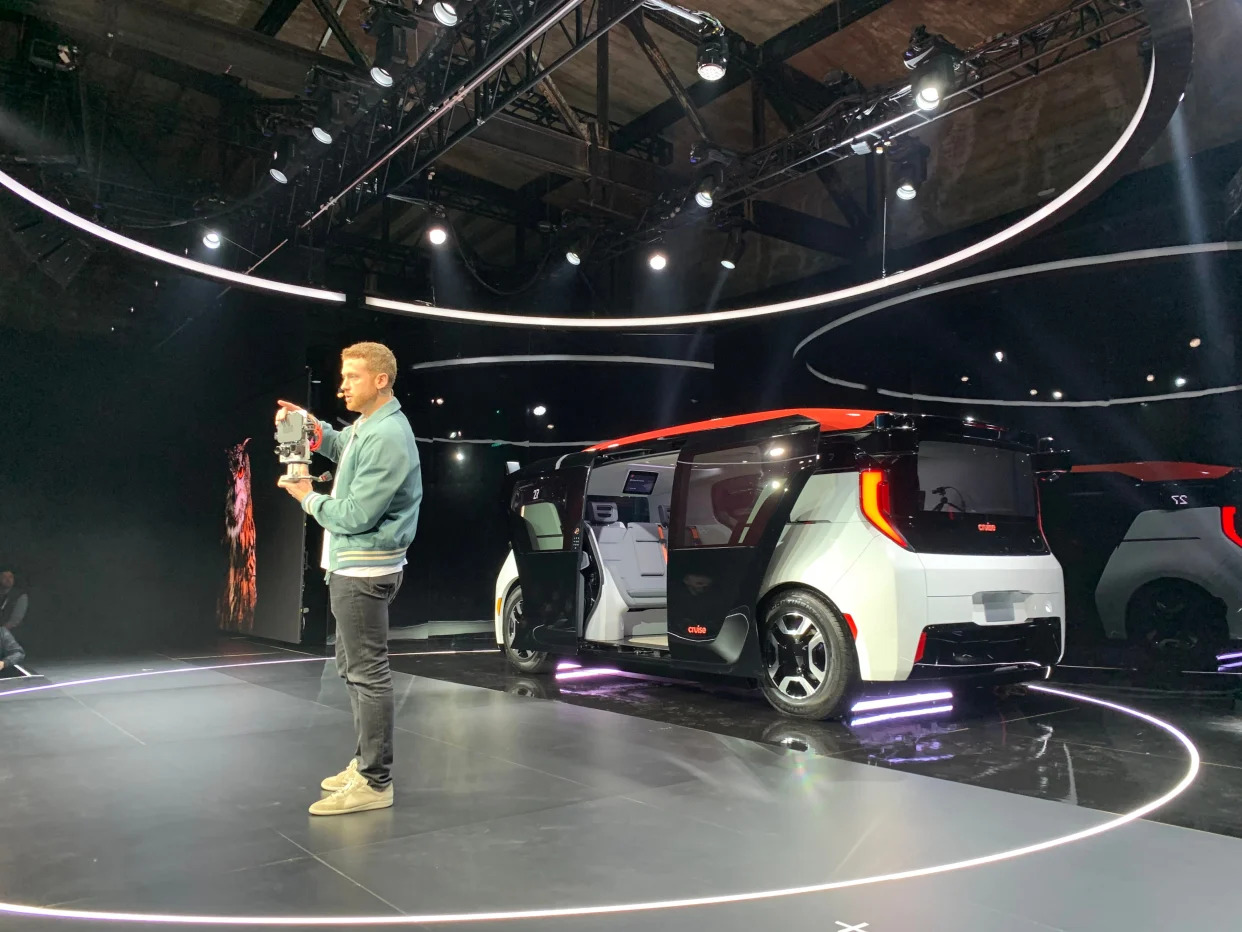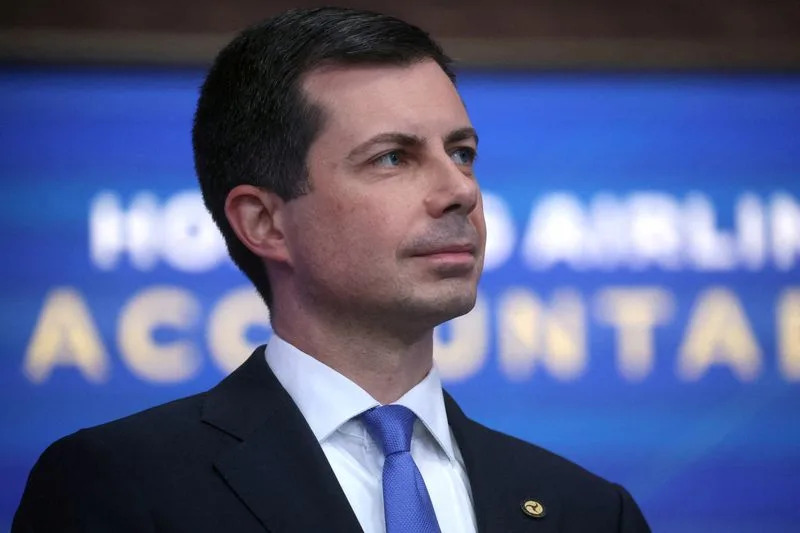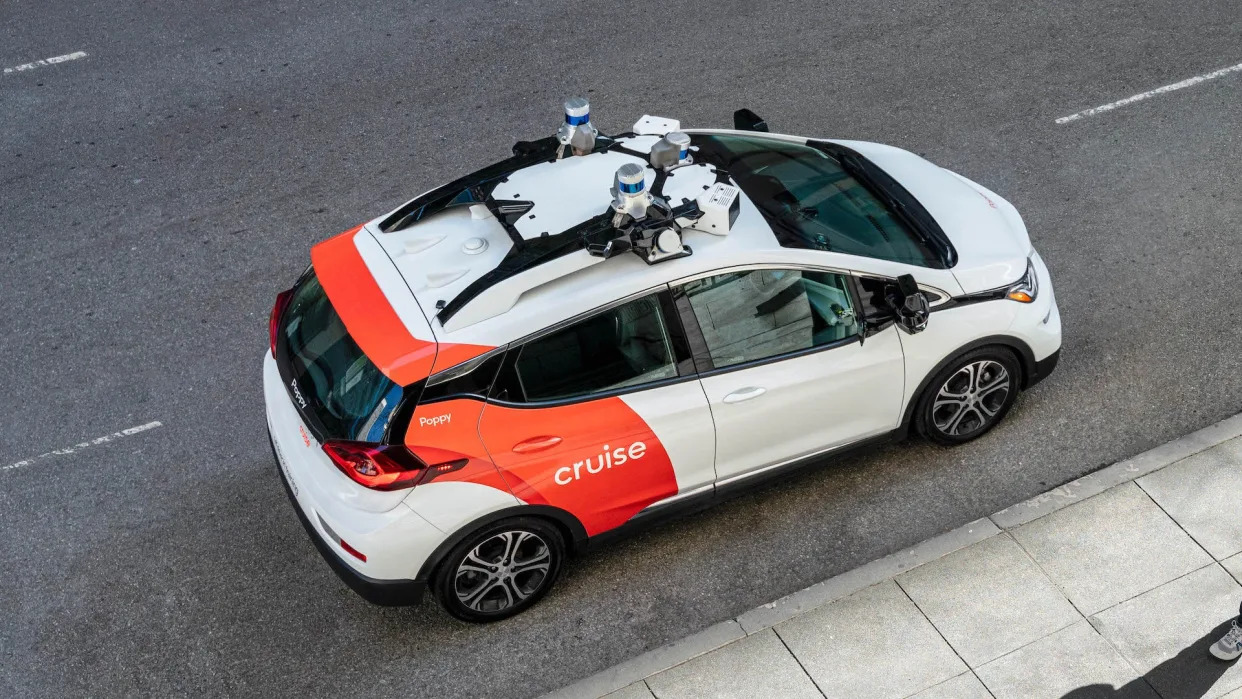Cruise CEO resigns after all of the company's robotaxis were forced to stop operating

Associated Press
Mon, November 20, 2023
Cruise's CEO resigned late Sunday.
Cruise recently lost its robotaxi permit in California after incidents involving its autonomous cars.
Earlier this year, a Cruise vehicle ran over a pedestrian, killing them.
Kyle Vogt has resigned as CEO of Cruise, General Motors' autonomous vehicle unit, as questions build about the safety of self-driving cars.
Vogt's decision to step down, announced late Sunday, follows a recent recall of all 950 Cruise vehicles to update software after one of them dragged a pedestrian to the side of a San Francisco street in early October. The California Department of Motor Vehicles revoked the license for Cruise.
The company earlier announced it had paused operations for a review by independent experts.
"The results of our ongoing reviews will inform additional next steps as we work to build a better Cruise centered around safety, transparency and trust," the company said in a statement. "We will continue to advance AV technology in service of our mission to make transportation safer, cleaner and more accessible."
Cruise won approval to transport fare-paying passengers last year. Since then, the autonomous vehicles have drawn complaints for making unexpected, traffic-clogging stops that critics say threaten to inconvenience other travelers and imperil public safety.
Late last year, U.S. safety regulators said they were investigating reports that autonomous robotaxis run by Cruise can stop too quickly or unexpectedly quit moving, potentially stranding passengers.
Problems at Cruise could slow the deployment of fully autonomous vehicles that carry passengers without human drivers on board. It also could bring stronger federal regulation of the vehicles, which are carrying passengers in more cities nationwide.
Cruise had been testing 300 robotaxis during the day when it could only give rides for free, and 100 robotaxis at night when it was allowed to charge for rides in less congested parts of San Francisco. Vogt earlier said most collisions were caused by inattentive or impaired human drivers, not the AVs.
Cruise's statement said its board had accepted Vogt's resignation. Mo Elshenawy, Cruise's executive vice president of engineering, will become president and chief technology officer. It said Craig Glidden also will serve as president and continue as chief administrative officer for Cruise, an appointment announced earlier.
GM acquired a majority stake in Cruise when it was a startup in 2016. The company invested to take 80% stake in the company in May 2021.
Vogt attended the Massachusetts Institute of Technology and was a co-founder of Twitch, an interactive livestreaming service for content including gaming, entertainment, sports and music. Amazon acquired Twitch for about $1 billion in 2014.

US transport chief aims to ensure Cruise, other self-driving vehicles safe
Updated Mon, November 20, 2023

U.S. Transportation Secretary Buttigieg listens as President Biden speaks at the White House in Washington, U.S.
By David Shepardson
WASHINGTON (Reuters) -U.S. Transportation Secretary Pete Buttigieg said on Monday the federal government will do everything it can using existing regulatory powers to ensure that General Motors robotaxi unit Cruise and other autonomous vehicles are deployed safely.
Cruise CEO Kyle Vogt resigned on Sunday, a day after apologizing to staff as the company undergoes a safety review of its U.S. fleet. Cruise pulled all of its vehicles from U.S. testing after an Oct. 2 accident in San Francisco that involved another vehicle and ended with one of Cruise's self-driving taxis dragging a pedestrian.
"We're going to do everything we can with the authorities we do have, which are not trivial," Buttigieg told reporters.
The National Highway Traffic Safety Administration (NHTSA), part of Buttigieg's department, has opened an investigation into whether Cruise is taking sufficient precautions to safeguard pedestrians.
In October, the California Department of Motor Vehicles ordered Cruise to remove its driverless cars from state roads, calling them a risk to the public and saying the company had misrepresented the safety of its technology.
Two dozen unions including the Transport Workers Union of America, International Brotherhood of Teamsters and United Auto Workers this month urged Buttigieg to do more to ensure the safety of autonomous vehicles (AVs), saying that "NHTSA must initiate an industry-wide investigation to determine the true extent of the safety failures behind the scenes."
Cruise's woes are a setback for an industry dependent on public trust and the cooperation of regulators. The unit had in recent months touted ambitious plans to expand to more cities, offering fully autonomous taxi rides.
Cruise competes with Alphabet's Waymo in deploying autonomous vehicles and had been testing hundreds in several cities across the United States, notably its home of San Francisco.
(Reporting by David Shepardson; Editing by Will Dunham and Chizu Nomiyama)
Controversial 'robotaxi' startup loses CEO
Andrew Paul
Mon, November 20, 2023
GM suspended all Cruise robotaxi services across the US earlier this month.
Cruise CEO Kyle Vogt announced his resignation from the controversial robotaxi startup on Sunday evening. The co-founder’s sudden departure arrives after months of public and political backlash relating to the autonomous vehicle fleet’s safety, and hints at future issues for the company purchased by General Motors in 2016 for over $1 billion.
Vogt’s resignation follows months of documented hazardous driving behaviors from Cruise’s autonomous vehicle fleet, including injuring pedestrians, delaying emergency responders, and failing to detect children. Cruise’s Golden State tenure itself lasted barely two months following a California Public Utilities Commission greenlight on 24/7 robotaxi services in August. Almost immediately, residents and city officials began documenting instances of apparent traffic pileups, blocked roadways, and seemingly reckless driving involving Cruise and Google-owned Waymo robotaxis. Meanwhile, Cruise representatives including Vogt aggressively campaigned against claims of an unsafe vehicle fleet.
[Related: San Francisco is pushing back against the rise of robotaxis.]
“Anything that we do differently than humans is being sensationalized,” Vogt told The Washington Post in September.
On October 2, a Cruise robotaxi failed to avoid hitting a woman pedestrian first struck by another car, subsequently dragging her 20 feet down the road. GM issued a San Francisco moratorium on Cruise operations three weeks later, followed by a nationwide expansion of the suspension on November 6.
But even with Cruise on an indefinite hiatus, competitors like Waymo and Zoox continue testing autonomous taxis across San Francisco, Los Angeles, Phoenix, Austin, and elsewhere to varying degrees of success. As The New York Times reports, Waymo’s integration into Phoenix continues to progress smoothly. Meanwhile, Austin accidents became so concerning that city officials felt the need to establish an internal task force over the summer to help log and process autonomous vehicle incidents.
[Related: Self-driving taxis allegedly blocked an ambulance and the patient died.]
In a thread posted to X over the weekend, Vogt called his experience helming Cruise “amazing,” and expressed gratitude to the company and its employees while telling them to “remember why this work matters.”
“The status quo on our roads sucks, but together we’ve proven there is something far better around the corner,” wrote Vogt before announcing his plans to spend time with his family and explore new ideas.
“Thanks for the great ride!” Vogt concluded.
GM Cruise CEO Quits Amid Robotaxi Fiasco
James Gilboy
Mon, November 20, 2023

Cruise AV in San Francisco
General Motors' automated driving division Cruise has suffered another blow as one of its founders departs. Formerly one of the leaders in driving automation, Cruise has been in a slump since one of its vehicles hit and dragged away a pedestrian in San Francisco.
Kyle Vogt, one of Cruise's two founders and later its CEO, declared Sunday on X that he had quit the company a decade after starting it. Vogt's departure likely stems from the Oct. 2 incident wherein a Cruise AV dragged away a pedestrian knocked into the vehicle's path by a hit-and-run. Cruise did not disclose that its vehicle had dragged the pedestrian 20 feet under the car while initially corresponding with regulators. When this information came to light, California suspended Cruise's permit to operate driverless vehicles on public streets.
Cruise also paused operations of its "supervised" AV fleet thereafter, which seemingly returned to service this month according to the company blog. However, employee morale at Cruise remains low according to TechCrunch, which reports the company has yet to find a replacement CEO and has laid off contracted workers.
On top of that, Cruise continues to hemorrhage cash, losing $728 million in Q3 and $8 billion since inception according to Reuters. GM CEO Mary Barra has remained supportive of Cruise, but GM's technical partner Honda has reportedly frozen further investment in the firm.
Cruise was founded in 2013 when vehicle automation looked like a surefire near-future technology. While pioneer Tesla pledged to have a driverless vehicle that could cross the country solo by 2017, the closest a publicly sold car has gotten is Mercedes partial eyes-off assist, which only arrived this year. Vehicular autonomy looks further out than ever, and increasingly like a money sink with little potential for payoff—if any at all.
Explainer-GM-owned Cruise's wrong turn could slow robotaxi push
Reuters
Mon, November 20, 2023

The San Francisco skyline is seen behind a self-driving GM Bolt EV during a media event where Cruise, GMÕs autonomous car unit, showed off its self-driving cars in San Francisco
(Reuters) - U.S. robotaxi operators could face increased regulatory scrutiny after an accident involving Cruise, the self-driving cab business of General Motors, forced the company to pause service.
In October, one of Cruise's driverless cabs was not able to stop in time from hitting a pedestrian who had been struck by a hit-and-run driver, raising safety concerns around the use of robotaxis.
Here's a quick rundown on the sector:
What are robotaxis?
Robotaxis are autonomous self-driving cabs which require no human interaction to operate the vehicle. The ride-hailing service can be availed through mobile apps.
How does it work?
The vehicles use machine-learning models and advanced systems to process information from technologies such as cameras and LiDAR sensors, as well as pre-existing data, to navigate around specified areas without a human driver required to make decisions.
When did driverless cabs become a reality?
Alphabet's Waymo was the first to kick off robotaxis in the United States in 2017.
Cruise followed with its first driverless ride service last year in San Francisco, and slowly expanded to include Phoenix, Arizona, and Austin, Texas.
Companies offering the service
Robotaxi services are currently offered in specific areas within the United States by Waymo, Uber Technologies and Lyft.
While Cruise paused its U.S. services for a safety review, it continues to undertake testing in closed course training environments, along with public testing overseas.
Amazon.com is also testing its robotaxi service, Zoox, to handle traffic lights, intersections and drive at speeds of up to 35 miles per hour.
When will robotaxis become mainstream?
While robotaxis offer the convenience of lower operating costs for cab operators, there are regulatory approvals and technological hurdles that need to be overcome before the cabs are widely adopted across states.
Lucid's CEO in 2021 said it was likely to take a decade before self-driving taxis would be deployed on roads, and they weren't "coming anytime soon even with the most advanced sensing systems in the world".
The use of driverless cabs also raises the prospect of job losses and could attract pushback from unions.
Are robotaxis safer than other cars?
On paper, robotaxis are supposed to offer better safety due to their advanced machine-learning models and a host of sensors designed to monitor traffic activity.
Newer models of the vehicles were also tuned to offer smoother braking and acceleration curves to give passengers a better ride.
However, the unpredictability of human drivers and pedestrians sometimes makes it difficult for the current autonomous driving tech to take quick decisions and navigate around hazards.
Regulatory hurdles facing robotaxis
Commercializing fully autonomous vehicles, especially robotaxis, has been harder than expected with tough regulations, complicated technology and heavy investments forcing some to cut jobs.
Some companies such as Ford and Volkswagen-backed Argo AI have also shut shop.
(Reporting by Nathan Gomes in Bengaluru; Editing by Devika Syamnath)
View comments
Cruise co-founder, CEO Kyle Vogt resigns
Aaron Tolentino
Sun, November 19, 2023

SAN FRANCISCO (KRON) — The Chief Executive Officer (CEO) of San Francisco-based autonomous vehicle company Cruise has resigned. Kyle Vogt, who is also Cruise’s co-founder, announced his resignation Sunday evening on X.
The announcement comes nearly one month after Cruise announced it will pull all of its driverless cars off the streets nationwide. The move was to “take steps to rebuild public trust” after Cruise’s autonomous vehicles have caused problems in San Francisco streets, including traffic jams.
Vogt founded the company 10 years ago, and Cruise has recorded more than 250,000 driverless rides across multiple cities, the company’s now-former CEO said on X. No announcement has been made on who will replace Vogt as Cruise’s CEO.
“Cruise is still just getting started, and I believe it has a great future ahead,” Vogt wrote on X. “The folks at Cruise are brilliant, driven, and resilient. They’re executing on a solid, multi-year roadmap and an exciting product vision. I’m thrilled to see what Cruise has in store next!
“As for what’s next for me, I plan to spend time with my family and explore some new ideas. Thanks for the great ride!”
No comments:
Post a Comment